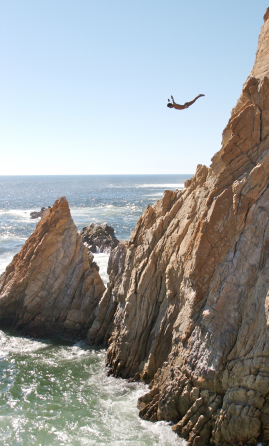Cliff Diving
Cliff Diving / Cliff Jumping
Learn to Cliff Dive: Information, Locations, Discussions, Equipment, Pictures & More

Choose a State for Cliff Diving:
Before any jump, inspect the entire area for sunken logs, underwater rocks, etc. Do not jump unless you have the necessary clearance under the water. Just because others are jumping in the same or similar area does not mean it is safe to jump. It only takes a few minutes to inspect the area. If inspections are not done or if calculations are wrong, the diver could face a life threatening situation. Hitting the bottom, underwater debris, or a rock along the side of the water opening can knock the diver unconscious and may result in drowning. It’s very important for this sport to be done with at least two people for that very reason. No diving while someone else is already in the water is also a rule that needs to be followed.
It’s not recommended for any jumper to dive from above 40 feet. Let’s just leave that to the professionals. Let’s take quick look at physics. By the time you reach the water from a ten foot cliff, you will be traveling at a speed of about 17 miles per hour. Your speed at 20 feet increases to roughly 25 miles per hour. You might think, “it’s just water so how can I get hurt”? Well you’ve thought wrong. The impact even when landing correctly can cause fractures, broken bones, compression injuries, concussions and even death. The correct way to land is vertically with your feet touching the water first. Never dive headfirst as a head injury underwater can be deadly.
Research the area (even ones listed on this site) to avoid breaking the law as some common locations are now illegal. That’s because those areas have been deemed unsafe. More and more areas are becoming illegal.
The aspect of danger with cliff diving is almost an attraction for some and adds to the adrenaline rush. Are you ready to take the plunge?
Cliff Diving near Ventura, California
Extreme Cliff Diving: 80+ Cliff Jump at Red Rock in Solvang, California
Cliff Diving at Fossil Creek in Strawberry, Arizona
Equipment for Cliff Diving
